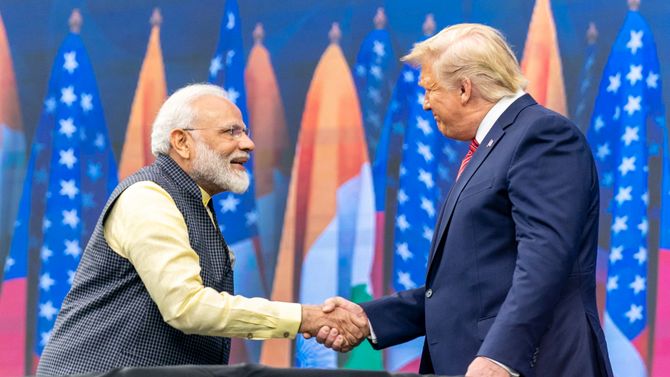There has never been a time when trade policy was conducted entirely separate from broader geopolitical issues. But trade has now become deeply and inexorably intertwined with national security issues and geopolitical risk. We’ve arrived at this point through the confluence of three factors:
- The growing usage of new dual use technologies (technologies that can be used for civilian or military applications)
- Intensifying geopolitical issues
- The failure of our existing WTO rules to provide coherent guidance on how to manage the interface between trade and security.
While these new realities are playing out most notably in US China relations, virtually all countries will be drawn in and trade policy will need to be recalibrated to reflect these complexities.
Implications of dual-use technologies for trade policy
Dual use technologies are infusing national security strategy dimensions into a growing range of products in ways that could not have been imagined even a decade ago.
The Internet of Things, 5-G technologies, AI, and smart-everything (smart cities, smart phones, smart trains, smart roads, etc.) means that seemingly mundane, everyday products now need to be assessed for their potential national security and societal implications.
National security strategy now at forefront of US China trade relations
Trade policy is now being recalibrated to reflect the complexities raised by dual-use technologies. Policy instruments such as investment reviews and export control regulations (and in some cases, restrictions) are being fortified to more stringently monitor which countries are able to receive potentially sensitive dual use technologies.
Import policies are also being adjusted to prevent potential malevolent foreign manipulation (through sophisticated imported technologies) of critical domestic infrastructure, and/or heightened vulnerability to cyber espionage activities.
The Huawei sanctions provide a good example. China’s national champion and global 5-G leader has not only been excluded from meaningful participation in the development of US 5-G networks, the US is also pressuring allies to implement a similar Huawei China ban. And US firms that have been supplying Huawei with critical technologies are at risk of facing Huawei sanctions.
China FDI into the US is facing much tougher scrutiny (especially in sensitive technology sectors) under the recent Foreign Investment Risk Review Modernization Act of 2018 (FIRRMA), which expanded the jurisdiction of CFIUS to do investment reviews related to US national security strategy and concerns over cyber espionage.
In return, China’s “unreliable entities” list targets foreign companies that have “severely damaged the legitimate interests” of Chinese firms. While details are vague, US tech giants like Google, Qualcomm, and Intel could be subjected to trade retaliation in response to US restrictions placed on Chinese companies on the basis of security concerns.
China’s Military-Civilian Fusion is heightening tensions with US
The more intense focus in the US on the security aspects of trade policy and China FDI has been partially fueled by China’s forthrightness in describing its own national security strategy.
Under the “Military-Civilian Fusion” (MCF) China technology strategy, the Chinese government is explicitly tapping private companies, investment funds, and research organizations to secure dual use technologies abroad that can be channeled into Chinese military applications. But the policy has a considerably grander strategic scope than just high-tech weaponry. It envisions a highly synergistic and mutually reinforcing synchronization between China’s economic development objectives (especially in China technology sectors) and its military aspirations.
In a sense, this means that trade policy needs to cope not only with an increasing number of dual use technology products, but also dual-use institutions (private companies, investment vehicles, research organizations, etc).
As a consequence, US China relations in trade are now being conducted with a steadily increasing national security awareness.
Ethics and technology
The nature of dual-use technologies can further complicate trade policy deliberations by raising value-laden societal issues not typically included in the realm of trade. For example, the potential for facial recognition technologies to be used to conduct sophisticated (and arguably intrusive) surveillance of citizens will bring into sharp relief the philosophical and governance differences between the US and Chinese systems. Debates related to ethics and technology will only get more frequent in the future.
While such a characterization ignores fundamental differences between now and then, the combination of China’s rising technological and economic might, along with obvious differences in governance, values, and philosophies does suggest a period of intensifying competition in US China relations, if not outright US China rivalry.
This heightened sense of competition breeds a more guarded approach to economic integration between the countries. Increased levels of trade and FDI, especially in strategic sectors, are no longer uniformly viewed as benign or desirable – from either country’s perspective, leading some to argue that we could be heading towards a decoupling of global value chains
Towards a global trade war?
US China relations are not the only ones under strain as their trade relationships taking on more overt geopolitical overtones.
Historical tensions and antipathies are now playing out in Japan Korea trade. Each country has slapped trade restrictions on the other, ostensibly due to security concerns. The more proximate cause however was a South Korean court decision which stirred up still-festering wounds from Japan’s colonial era. In any case, geopolitical issues are now driving a sharp deterioration in Japan Korea trade, which has to date been a large and mutually beneficial trade and investment relationship.
Meanwhile, in the Western Hemisphere, the US recently threatened to implement punitive tariffs on Mexico on the basis of entirely non-trade-related geopolitical issues: dissatisfaction with Mexico’s migration policies.
In Southeast Asia, products and services which include or reference the politically sensitive “nine-dash-line” map (which takes an expansive view of China’s territorial claims) are being restricted, modified, or in some cases prohibited. The resulting trade distortions are being felt in sectors ranging from motor vehicles with navigation apps to motion pictures.
Moving forward, the impact of geopolitical issues on trade will likely intensify. For instance, an increasing number of third countries will find themselves drawn into the tensions of the US China relations whether they wish to be or not.
Consider article 32.10 of the US-Mexico-Canada Agreement (USMCA), which essentially says that if one of the partners enters into an FTA with a “non-market economy” the other two parties can abrogate the trilateral deal and default to a bilateral agreement. The implications of this provision are crystal clear. Although the word “China” does not appear, it is clearly directed towards China and is designed to give Canada or Mexico reason to pause before they consider pursuing a China trade agreement. Perhaps more importantly, US officials have been entirely open about their intention that this provision serve as a template for inclusion in future trade agreements.
The broader geopolitical issues that permeate US China relations are thereby being explicitly inserted into bilateral or regional trade agreements the US pursues with third countries.
Trade negotiations and trade policy deliberations are now being influenced by geopolitical risk to an extent we have rarely seen before.
WTO rules need reform
WTO rules unfortunately do not shed much light on how to manage the complexities of trade, geopolitical issues, and security.
While WTO rules do attempt to nominally deal with trade actions taken on the basis of national security, these provisions are glaringly insufficient.
GATT Article XXI(b)(iii) permits a WTO Member to take any action “which it considers necessary for the protection of its essential security interests taken in time of war or other emergency in international relations.”
The remarkable broadness of this provision gives license to member economies to essentially do what they deem appropriate under the rubric of national security strategy. This might have been a workable approach in previous times, when trust and restraint were higher, but it is entirely inadequate in today’s world.
Russia WTO national security case signals initial progress on clarifying WTO rules
A WTO Dispute Settlement ruling in April 2019 marks the first potential, tentative step towards greater clarity on WTO rules for trade and security. Ukraine had brought the case against Russia, arguing that in the aftermath of Russia’s 2014 military intervention, Russia had contravened WTO rules by restricting Ukraine’s access to trade routes.
In its defense, Russia argued that it was justified in taking these steps under the national security provisions contained in GATT Article XXI. The WTO Dispute Settlement Panel however rejected Russia’s argument, in particular its claim that the national security provisions were “self-judging”.
This was the first time that the national security exception had been invoked or probed, and as such is the first attempt to flesh-out exactly what it means. But we still have a long way to go. And in the meantime, Pandora’s box has been opened, and trade actions will continue to be taken on the basis of national security concerns that are oftentimes flimsy at best.
Needed: More transparency and better WTO rules
Trade policy was undeniably simpler when national security and geopolitical issues were largely relegated to the background. In adjusting to the new realities, a couple of principles might be helpful.
A second useful approach would be to delineate the WTO rules on national security more explicitly. The starting point should be to specify what circumstances do – and do not – justify taking trade actions based on national security grounds.
Ultimately, more explicit rules on justifiable use of this provision would have to be codified. While this would not be a comprehensive solution, it would put us on much clearer and firmer ground than today’s “anything goes” environment.
Greater transparency and clearer WTO rules will help us – at least somewhat – navigate this new landscape in which trade, security, and geopolitics are tightly intertwined. But there is no escaping the simple reality that trade policy has now become more complex – and combustible – than any time previously.
© The Hinrich Foundation. See our website Terms and conditions for our copyright and reprint policy. All statements of fact and the views, conclusions and recommendations expressed in this publication are the sole responsibility of the author(s).









